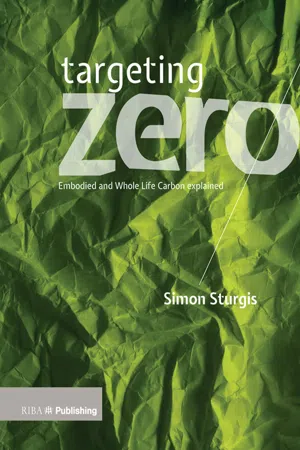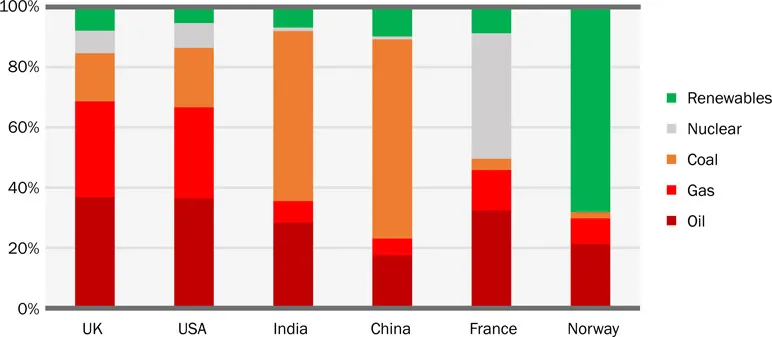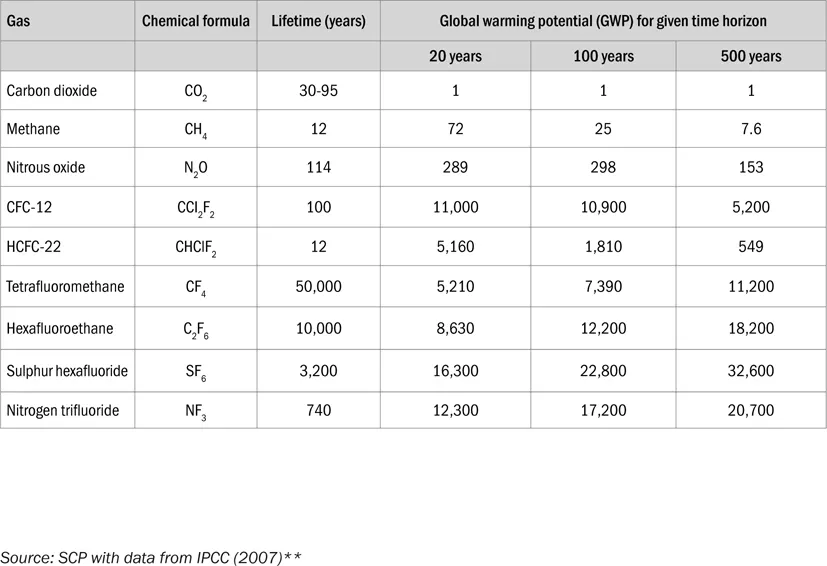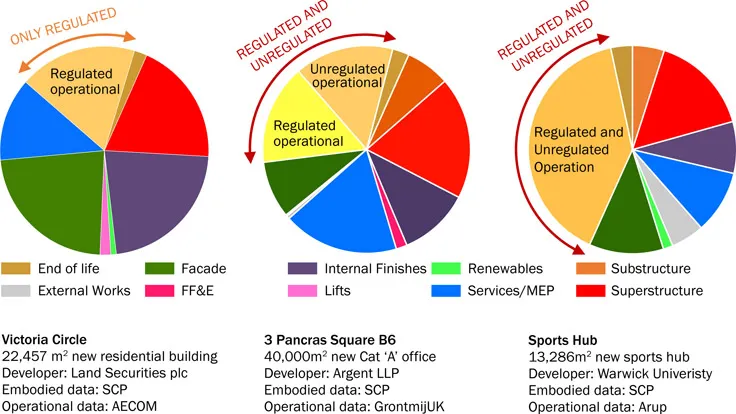
eBook - ePub
Targeting Zero
Whole Life and Embodied Carbon Strategies for Design Professionals
- 128 pages
- English
- ePUB (mobile friendly)
- Available on iOS & Android
eBook - ePub
About this book
Embodied and Whole Life Carbon will change the way buildings are designed, yet carbon emissions associated with the construction and life of buildings are not yet wholly understood by the profession. Energy is assumed to be the province of services engineers, yet energy from materials is as big an issue. Architects have the opportunity to take the lead in redefining how buildings are designed to achieve a low carbon future.
Frequently asked questions
Yes, you can cancel anytime from the Subscription tab in your account settings on the Perlego website. Your subscription will stay active until the end of your current billing period. Learn how to cancel your subscription.
No, books cannot be downloaded as external files, such as PDFs, for use outside of Perlego. However, you can download books within the Perlego app for offline reading on mobile or tablet. Learn more here.
Perlego offers two plans: Essential and Complete
- Essential is ideal for learners and professionals who enjoy exploring a wide range of subjects. Access the Essential Library with 800,000+ trusted titles and best-sellers across business, personal growth, and the humanities. Includes unlimited reading time and Standard Read Aloud voice.
- Complete: Perfect for advanced learners and researchers needing full, unrestricted access. Unlock 1.4M+ books across hundreds of subjects, including academic and specialized titles. The Complete Plan also includes advanced features like Premium Read Aloud and Research Assistant.
We are an online textbook subscription service, where you can get access to an entire online library for less than the price of a single book per month. With over 1 million books across 1000+ topics, we’ve got you covered! Learn more here.
Look out for the read-aloud symbol on your next book to see if you can listen to it. The read-aloud tool reads text aloud for you, highlighting the text as it is being read. You can pause it, speed it up and slow it down. Learn more here.
Yes! You can use the Perlego app on both iOS or Android devices to read anytime, anywhere — even offline. Perfect for commutes or when you’re on the go.
Please note we cannot support devices running on iOS 13 and Android 7 or earlier. Learn more about using the app.
Please note we cannot support devices running on iOS 13 and Android 7 or earlier. Learn more about using the app.
Yes, you can access Targeting Zero by Simon Sturgis in PDF and/or ePUB format, as well as other popular books in Architecture & Architecture General. We have over one million books available in our catalogue for you to explore.
Information
Topic
ArchitectureSubtopic
Architecture General1
Embodied, operational and whole life carbon
Overview
Carbon emissions from the creation of the built environment derive principally from energy used in the construction process. This largely means energy generated from fossil fuels, ie coal, oil and gas. Energy supplied from renewable sources, nuclear power and hydroelectric power does not generally produce direct operational carbon emissions. (It is, however, worth noting that the process of building, for example, wind turbines consumes a significant amount of energy, so the provision of wind power is not totally free of carbon emissions.)

Figure 1.01: Global energy consumption by country in 2014: six examples.
Currently in the UK, and for the medium term at least, reducing carbon emissions is substantially about reducing energy use. Buildings use energy to operate, known as ‘operational energy’, which produces ‘operational carbon emissions’.
Sourcing materials, constructing, repairing and maintaining buildings are also responsible for significant energy use – this is referred to as ‘embodied energy’, giving rise to the term ‘embodied carbon emissions’. The country from which your materials are sourced – ie under which sort of energy regimes they are extracted and fabricated – will have an impact on the carbon footprint of that material. Electricity used by industry in the UK is generally from a mix of sources; sourcing outside the UK can open up opportunities for procuring low carbon materials – but a word of caution: transport methods to a UK site can counteract these benefits.
‘Whole life carbon emissions’ are both the operational and the embodied emissions considered together over the life of the building. A key point is that considering operational or embodied emissions in isolation can lead to poor decision-making with unintended consequences.
The terms ‘carbon’ or ‘carbon emissions’ as used in this book actually refer to ‘carbon dioxide emissions and their equivalents’, or CO2e, where the ‘e’ refers to a bundle of greenhouse gases (GHGs) that have similar negative impacts to CO2 but at a significantly worse level per kg of the gas.

Legislative background – the short story
The European Committee for Standardization, known as CEN, has technical committees (TCs) that produce standards on a whole range of activities and processes for use across the EU. The one that concerns us for carbon emissions reduction is CEN/TC 350, the standard for sustainability of construction works, produced in 2005.
In addition to CEN/TC 350 is the UK Low Carbon Transition Plan: National strategy for climate and energy, presented to Parliament by the government on 15 July 2009. For our purposes, the key extract from the ‘five point plan’ is item four:
4. Building a low carbon UK
To play our part in reducing global emissions, Britain needs to become a low carbon country. The 2008 Climate Change Act1 made Britain the first country in the world to set legally binding ‘carbon budgets’, aiming to cut UK emissions by 34% by 2020 and at least 80% by 2050 through investment in energy efficiency and clean energy technologies such as renewables, nuclear and carbon capture and storage.2
This document focuses principally on reducing operational energy use in buildings, but not embodied energy; nor did it consider the possible implications of pursuing an operational energy-only approach.
However, in the autumn of 2010, The UK Department of Business Innovation and Skills’ innovation and growth team (IGT), under the direction of the government’s chief construction advisor, Paul Morrell (formally senior partner of Davis Langdon), produced its final report on low carbon construction. This excellent document posed the question ‘Is the construction industry fit for purpose for the transition to a low carbon economy?’ The answer was, of course, no. The report challenged industry to get to grips with the issue; the following recommendations get to the nub:
Recommendation 2.1: That as soon as a sufficiently rigorous assessment system is in place, the Treasury should introduce into the Green Book a requirement to conduct a whole-life (embodied + operational) carbon appraisal and that this is factored into feasibility studies on the basis of a realistic price for carbon.
Recommendation 2.2: That the industry should agree with Government a standard method of measuring embodied carbon for use as a design tool and (as Recommendation 2.1) for the purposes of scheme appraisal. 3
In November 2011 the British Standard BS EN 15978:2011 was produced, essentially replicating CEN/TC 350 and bringing it into the British Standards framework. Unless repealed post-Brexit, this remains the point of reference. This standard sets out a whole life methodology, covering both operational carbon emissions and embodied emissions and including reuse, as per the circular economy. (See Chapter 6 for detail on BS EN 15978.) This represents the basis on which embodied and whole life carbon emissions are understood and assessed today. However, early use of BS EN 15978 led to incomparable assessments as different consultants, responding to clients with differing reporting requirements, interpreted the BS inconsistently.
In 2015, InnovateUK provided funding for a team (see Introduction for details) led by the author to produce an implementation plan for making BS EN 15978 consistent and understandable in use, and usable and accessible through RICS certification. The objective was to create a consistent plan for UK- and potentially EU-wide use that brings embodied and whole life carbon into the mainstream.
Carbon emissions in the built environment can be an odd concept to grasp, particularly with respect to materials. In the next sections, I explain what I understand by operational, embodied and whole life carbon emissions.
Operational carbon emissions
These are the emissions from energy used to operate a building. In the UK these are split into ‘regulated’ – namely those covered by legislation (Part L of the Building Regulations), such as heating, lighting and cooling – and ‘unregulated’, which covers small power use such as TVs, kettles, computers, fridges and so on. Reducing regulated emissions has a direct impact on the design of the building fabric through measures to reduce the need for energy consumption, such as increased insulation, double glazing, low energy lighting, etc. The Building Regulations (Part L) have evolved specifically to reduce the amount of energy used to heat, cool and light buildings, and have been very successful in improving the environmental performance of buildings.
The Passivhaus standard is an example of the optimum in environmental performance, in which regulated operational energy use is reduced to a practical minimum. This German-originated building standard provides for performance levels much higher than the UK Building Regulations, and is achieved through very high levels of insulation, airtightness, triple glazing, elimination of cold bridging and other measures.
The success of the UK Building Regulations has been in reducing building performance-related operational carbon emissions over the decades since their introduction. The point has been reached where further reductions, by way of further mitigation or the use of renewables, are becoming increasingly expensive – or, at least, are certainly perceived as being so (this is particularly true of many house builders, who see any increase in environmental standards as a direct cost). This view, although not necessarily accurate, particularly over the long term, has created a negative ‘mood music’ around sustainability and has led to the government backtracking on environmental legislation. For example, in October 2011 the then chancellor George Osborne, who prior to the 2010 election had promised that his Treasury would be ‘a green ally, not a foe’, told his party conference that saving the planet risked ‘putting our country out of business’.4
Relative impacts of operational and embodied emissions

Figure 1.02: Relative impact of individual life cycle stages on the overall carbon footprint for different types of buildings, calculated over 30 years. Red arrows by author indicating embodied carbon proportion. (The energy results have been based on the Building Regulations.)
Analysis by the Royal Institute of Chartered Surveyors5 and others shows that the proportion of embodied energy in relation to that of regulated operational energy is, in most new building typologies, greater than 50%, as shown in the above diagram where the green colour represents operational emissions. SCP has done similar analyses (see below) that support this view.

Figure 1.03: WLC analyses – range differences between operational and embodied emissions.
Such data conflicts with a general perception that embodied carbon is a relatively small part of the overall lifetime emissions of most building types (see What Colour is Your Building? by David H. Clark, 2013, see Figure 3.07, page 51 – this section suggests that the embodied/operational ratio is 20%/80%).6 This discrepancy can be partly attributed to the fact that, although buildings are becoming operationally more efficient all the time, the data reviews that have influenced thinking on the relative proportions tend to use data that predates the last few years, ie from before BREEAM 2011 and 2014 and Part L 2010 and 2013 effects were included. As buildings get more operationally efficient, so the embodied proportion increases.
The principal reasons however are that the following reporting deficiencies with reference to the BS EN 15978 modules have contributed to these discrepancies (see also Chapter 6):
- 1. Under-reporting for modules A, B, and C: This is generally down to reduced scope, since many assessments are only concerned with structure and cladding, ie they do not cover all elements of construction nor the interior fitout.
- 2. Under-reporting for modules B2-B5: Most assessments omit a proper analysis of maintenance, repair, replacement and refurbishment on the grounds of perceived complexity, or lack of knowledge. In practice, the life cycle emissions of these activities over 60 years can be significant: in the case of new office buildings, the embodied emissions over 60 years can be similar to those of the original construction. For example, for the Cat A office project T2, for Argent LLP, the approximate whole life carbon split at completion of RIBA Stage 3 was as follows.
- Embodied carbon to practical completion: 36%
- Embodied carbon over 60 years, plus disposal: 30%
- Operational carbon (regulated and unregulated) over 60 years: 34%
In the case of an owner-occupier, you would also have to include their internal upgrades over the 60-year period. This would significantly increase the embodied carbon proportions shown above.
- 3. Under or non-reporting of module C: Most assessments exclude a meaningful assessment of the end of life, ie the demolition and disposal carbon emissions. Although this can be difficult to analyse, it is an important consideration for resource-efficient design.
In aggregate, such under-reporting has meant that embodied carbon impacts have been misunderstood by the built environment industry. This is starting to change thanks to better understanding and better data, but it remains a significant point since it suggests that, while pressure to reduce operational emissions should continue, there are embodied (ie material-related) ways of making substantial carbon emissions reductions in the built environment at low or even zero cost. The implication is that, on the grounds of both cost and impact, the focus for carbon reductions in the built environment should spread to include embodied emissions in the form of a whole life approach. For architects and structural engineers, this means a shift in emphasis to materials and their efficient deployment rather than energy use efficiency, which is more in the remit of the services consultant.
Embodied carbon emissions (see Chapter 6 for methodology)
Sometimes also called embedded or capital carbon emissions, these are the emissions associated with the sourcing of raw material, transportation to a factory, fabrication into components and systems, delivery to site, and assembly into a building up to practical completion. Following completion, embodied emissions also refer to maintenance and replacement over an assumed building life expectancy, and final disassembly and disposal. Disposal can include reuse and recycling, meaning that redundant material is no longer waste but raw material for the next phase of use.
This holistic approach t...
Table of contents
- Cover
- Title
- Copyright
- Contents
- Acknowledgements
- Foreword
- Introduction
- Chapter 1: Embodied, operational and whole life carbon
- Chapter 2: Whole life carbon – practical application
- Chapter 3: Recycling, reuse and the circular economy
- Chapter 4: Low carbon design – macro scale
- Chapter 5: Low carbon design – human scale
- Chapter 6: Methodology
- Chapter 7: Conclusions – what’s next?
- References
- Glossary
- Acronyms
- Image credits
- Index
- Carbon Impact of 1 book over a generation